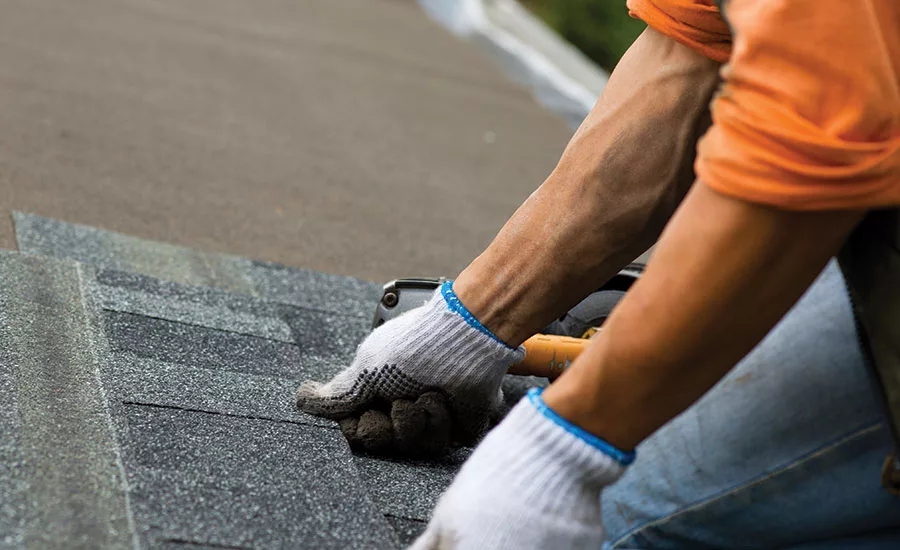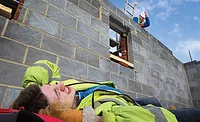Three Dangerous Roofing Contractor Myths


Everybody makes mistakes. Albert Einstein once said, “The person that never made a mistake, never tried anything new.” As usual, Einstein is right. However, the bigger misfortune is to make mistakes over and over as a business norm. Having been an active consultant in the roofing industry for over 25 years, I would like to share some of the common blunders I see roofing contractors make.
“No one ties off in residential roofing, so why should I.”
Roofing is a dangerous business. While the Occupational Safety and Health Administration (OSHA) and state inspectors may tend to focus on commercial sites, residential work sites are not exempt. Seventeen percent of disability occupational accidents are from falls. It’s not an issue of if someone falls, but rather when someone falls. Just because you use subcontractors on a residential jobsite or have the “everyone else does it” mentality, does not allow you to break the law. A lot of folks drive under the influence of alcohol, but if you do so and kill someone, telling the judge that everyone does it will not get you off the hook.
It’s also a moral issue. Do you really want to be responsible for a jobsite death? I’ve had conversations with more than one contractor customer who has experienced one. It’s an awful conversation. Practice safety. Yes, guys will complain and insist it slows them down, but studies have shown that once workers are accustomed to wearing the devices, little productivity is lost. I also recommend you have a relationship with a local safety consultant. If you have someone fall off a roof, you must have a cellphone number handy where you can immediately get a safety professional to that jobsite to offer assistance. When the accident occurs, and the police and coroner are on your jobsite and state regulator and OSHA are on the way; it’s too late to thumb through a phone book to find a safety advisor.
Fines are very expensive regarding willful safety violations and, in some cases, criminal violations can apply. For commercial contractors, safety is a matter of survival. Many jobsites require a low Experienced Modifier Rate (EMR) on worker’s compensation to even bid on a job.
“I pay a sales commission so it really doesn’t cost me anything.”
Let’s start with an understanding of how you arrived at that commission. Is your plan carefully thought out or just a number built on industry averages and other myths? The price of shingles has dramatically risen over the last few years. A roof that cost $10,000 five years ago might sell for $15,000 today. If you merely pay an arbitrary commission percentage, such as 10 percent (which I believe is too high but multiplies easily), you have increased the commission on that job from $1,000 to $1,500. How many people do you know that received a 50 percent raise over the last five years? Not very many. Just because something is easy to calculate, does not mean it’s the right number. In the old days, salespeople generated their own leads by knocking on doors. With the Internet, rarely is that the case today.
Let’s run the numbers. If you pay 10 percent commission and your average job size was $10,000, that would equal $1,000 per roof. If someone sold two roofs a week, they would make $2,000 a week or $100,000 a year. If a salesperson sold one-third of the jobs you looked at, you would only need to make six sales presentations a week to make that $100,000. Sounds like a pretty good job to me.
So, how do your figure the commission? Start by looking at the pay range for salespeople. Suppose in your market, a mediocre sales rep. would make $50,000 a year and a great one would earn $100,000. Work backwards to see what the person needs to sell and at what gross profit to make the numbers work. Use this logic to build a program. Every market and company are different and I can’t provide a magic formula. Think about it and work it out. It ultimately comes back to the fact that both the company and salesperson need to be paid fairly.
Paying commissions can only cost you money if your salesforce has a low closing rate or blows off some of your leads. Lost opportunity sales costs are real and a waste of your advertising dollars.
“I subcontract everything and price per square, so I can’t lose money.”
Pricing and paying labor per square only ensures that you’ve controlled your install cost. It doesn’t ensure that you’re doing the job at a high enough price to recover overhead costs and make a profit.
The following are fictional numbers and it’s important to follow the logic, not the specific math. Suppose a roofer sold roofing for $250 a square and the sub labor and material cost came to $175 per square. That would leave $75 per square gross profit to cover overhead. Now suppose a contractor determines the company’s overhead is $1,250 a day and anything over $1,250 is profit.
A 20-square roof that can be done in one day would generate $1,500 daily in gross profit ($75 per square gross profit x 20 squares). A $1,500 gross profit minus $1,250 in overhead leaves a $250 daily profit.
However, a 30-square roof that takes two days would lose money at this same price, even though it’s a bigger job. A 30-square roof that takes two days to install would generate $1,125 a day gross profit ($75 per square gross profit x 30 squares = $2,250 gross profit divided by two days). A gross profit of $1,125 per day minus $1,250 in overhead leaves a daily loss of $125.
Overhead is a function of time not sales. Rent, office salaries, truck payments and most other overhead costs are paid per week or month, not so much per sale. In roofing, weather also limits the number of days you have and are able to work. Therefore, to obtain the most accurate overhead recovery method, you should look at recovering a certain amount of overhead costs per day. It may be a little time consuming to figure out how many production days you have a year, but you can do it.
The above examples are fairly common industry practices but just because something is easy or simple, does not make it correct.
Looking for a reprint of this article?
From high-res PDFs to custom plaques, order your copy today!




